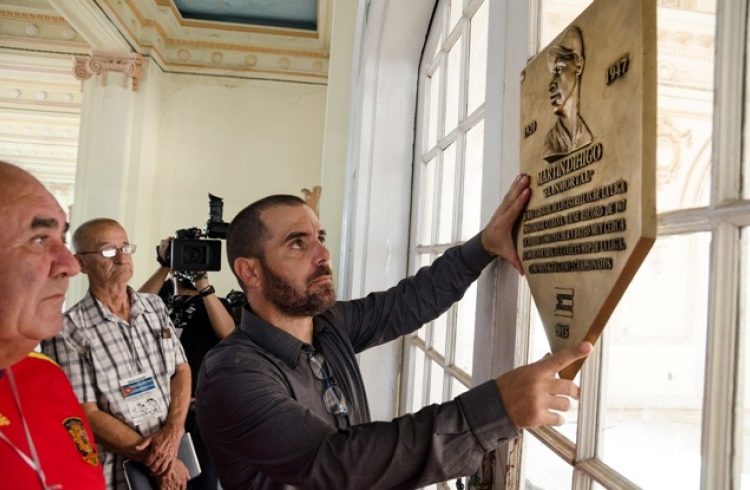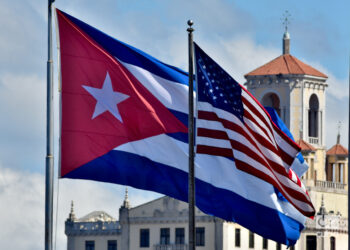Ian Padrón just gathered all looks on the latest installment of the Lucas Awards, but it is not the reason that brings him to this interview, but another, as Benedetti would say, “deeper and simpler”. The reason is baseball, specifically the recent re-founding of the Hall of Fame in Cuba.
The public links Padrón with baseball since 2003, when he released that anthological documentary, “Fuera de Liga”. However, his essential contribution to our hobby is, as he accepts, is to have spearheaded efforts of the management group who raised a child asleep for over half a century.
“In the last four months I have put aside my personal and professional life because I feel I’m doing something useful for my country. So I moved to tears the day that the restoration of the Hall became official. Nobody can say that this is not a noble act, an act of nationalism and respect for baseball. The child is already reborn. Now it is about wrap him up, take care of mosquitoes, immunizing against misunderstandings, but is now back among us. ”
How did this process that gave us back the Hall of Fame start?
When this summer I was invited to the “Al duro y sin guante” program, I said publicly that I was willing to give several years of my life as a filmmaker for Cuba to have a Hall of Fame and Baseball Museum. Then several people contacted me interested in pursuing this project, and my office became a meeting place for a group that began working on August the first and we decided to call it “Enthusiastic for the re-founding of the Hall of Fame”.
What lines of work concentrated their efforts?
We took on the task of researching, comparing regulations of other Halls; we reviewed how it was done in Cuba before …, and out came a result that was serious enough to convince many people. It has been an inclusive work that assimilated criteria from experts from around the country, as it should be for that it was a national effort. We are not a government agency, but an academic group which by the way was also joined by people of culture. Ultimately, the work resulted in early November that the “Colloquium for the re-founding of the Hall of Fame”, attended by officials of INDER and the National Commission, as well as most of the country’s most influential media.
Did you ever think that the Colloquium would not achieve its goal?
We did not have time to think about the defeat, we always thought it was a triumph of sport, culture and Cuban society, because a country that doesn’t look to the past cannot have a good future. It’s good to say that all the time we have the support of the Commission, first headed by Higinio Velez and now by Heriberto Suárez, because from the beginning we let them know we worked with seriousness and absolute respect.
Definitely, it was very ironic that Cuba did not have its Hall…
Besides the US, there is no country in the world whose nationality formation is so close to baseball as ours. It was a shame that we lacked a space to honor the immortals of our baseball. The Hall of Fame is an element of popular tradition, and history no one can deny. I repeat, I was ashamed that countries from as little baseball roots as Spain and Germany undertake inductions, and in Cuba that did not happen for about 54 years.
And that despite we had a Hall almost on par with the US…
In fact, we were so early that our first inductees arrived in 1939, just three years later than in North America. And from then till the triumph of the Revolution, 68 characters found place in the Hall. By the way, it seems very important to clarify that the word “fame” is not of Anglo-Saxon origin, but from the Latin, so we must not have any fear or predispose to it by its apparent capitalists or American overtones.
Does the project is limited to erect an enclosure for the immortals, or is it enriched by other elements?
What we want to do is something beyond a gallery with plaques and pictures; we want a National Baseball Museum covering all eras of baseball and show from the costumes to the implements used. We have also proposed a library and specialty store, a school where children receive clinics from great players…
What would be the location indicated for such an ambitious idea?
When we went to explain our interest in the Heritage Commission, it became clear that the ideal facility was the former Vedado Tennis Club, now “Jose Antonio Echeverria” Social Club, a place to be restored, but not built from scratch. It is an impressive construction, with the majesty of the history of baseball, located in a place accessible to many people. It is an emblematic Cuban amateur site where the Central American and the Caribbean Games took place in 1930, stars as Adolfo Luque and Conrado Marrero played, and even had in its coaching staff the great Martin Dihigo. Certainly, it should take a substantial investment to restore the roofs of the Echeverría, but I believe that if the State is determined to restore the Hall, in two years we could have a good facility. Let´s not forget that this could be the most visited museum in the whole country, in the words of specialists of the Heritage Commission.
Many people say that the Hall should have been erected in the Palmar de Junco…
Above chauvinists’ criteria, in the Colloquium only one language was spoken: the Cuban baseball. Matanzas own historians now accept that the Vedado Tennis Club was the best option. There the result was sought was achieved because everyone present, people from all corners of the island, think about what was best for Cuba, not for Havana, Matanzas or Santiago. Note that the induction ceremony this year will not be in any of these provinces but in Bayamo, Granma, where national anthem was first sung
So we can dismiss the argument that the capital was privileged?
Of course. This Hall is the continuity of the one that existed in Cuba since 1939, is the reestablishment of an institution that should never be abolished. In 1939 the Hall of Fame was at La Tropical and then went to Estadio del Cerro, Latinomamericano Stadium today. It was never outside the capital. We reviewed the reviews at the time and there is no suggestion or complaint regarding the site where it had been established. Not even speaking of Palmar de Junco. At this stadium, which is a gem of our history the first documented game in the press was played on December 27, 1874, but it was not the first official game in the country. Instead, on December 29, 1878 in Havana the Professional League was born, and that by itself is the most important Cuban baseball date at all times. Without it you cannot write the history of the national ball; without the Palmar de Junco, maybe yes. The legendary Matanzas stadium has poor structural conditions, is not in a place easily accessible to visitors, and doesn’t have parking area and other possibilities. Regardless of historical merits, infrastructure and viability are needed to carry out the projects. Otherwise, the Museum of the Revolution would be located on the Moncada Garrison.
What are the requirements to be eligible for the Hall?
The rules for the induction have nine key points, but the main requirements are to have played at least one decade, it doesn’t have to be entirely in the Cuban leagues, and being inactive in baseball for five years. Regardless, no Cuban players are eligible who at some point gave luster to professional championships in the country. With respect to residence, the regulation says that where he resides currently doesn’t disable the player to be part of the Hall, even in the event that he changed nationality. A Selection Committee composed of 25 members, elected by national experts themselves are responsible for voting annually for the inductees, who must win more than 75 percent of the vote both for players of prerevolutionary stage and for players of National Series. However, in the event no one obtains that percentage those most voted would be exalted inducted in each of the two stages, regardless of the fact they exceed or not the limit. That will ensure that each year we have inductees, unlike the majors, where 11 times no one has achieved the minimum votes required.
However, in the Colloquium was approved to disqualify those players who are guilty of doping cases of blood or (I quote) “unworthy attitudes” …
That clause was not passed unanimously, but approved by the majority. To me it seems too ambiguous. We should deepen what we mean by the word “unworthy”, as well as define what ” cases of blood ” we mean.
Could it be that “unworthy attitudes” refers to the defections?
The regulation clearly says no one would be excluded because they don’t live in Cuba, it would be something that we don’t seem ethically correct.
But one day Antonio Pacheco, Agustín Marquetti or Orlando Hernandez could be inducted, to cite three cases. Could that detract official endorsement for the Hall?
I do not want to play at being Nostradamus, it is important that we have the Hall there again. When the time comes that they choose a player who participated in the National Series and then migrated to America, we´ll see what happens. But I trust in the cultural level and love of history with the Cubans, and hope nothing again prevent our Hall of Fame from working. Cuban baseball is big enough not to be afraid of trifles, and those players who do not live here deserve the same respect that those who do. If those players are one day inducted, it would show the strength of our sport, because none of those players was formed out of Cuba.
Do you feel optimistic for the first induction in many years, on December28th?
Much. Even we are making arrangements for Orestes Minoso and Camilo Pascual, now inducted, to come to Cuba for the ceremony, and the responses are very positive, much respect and enthusiasm for the idea. I tell you, do you think if I was not optimistic I would be sitting here? Do you think this would be achieved if not with the full conviction that this could be achieved?










